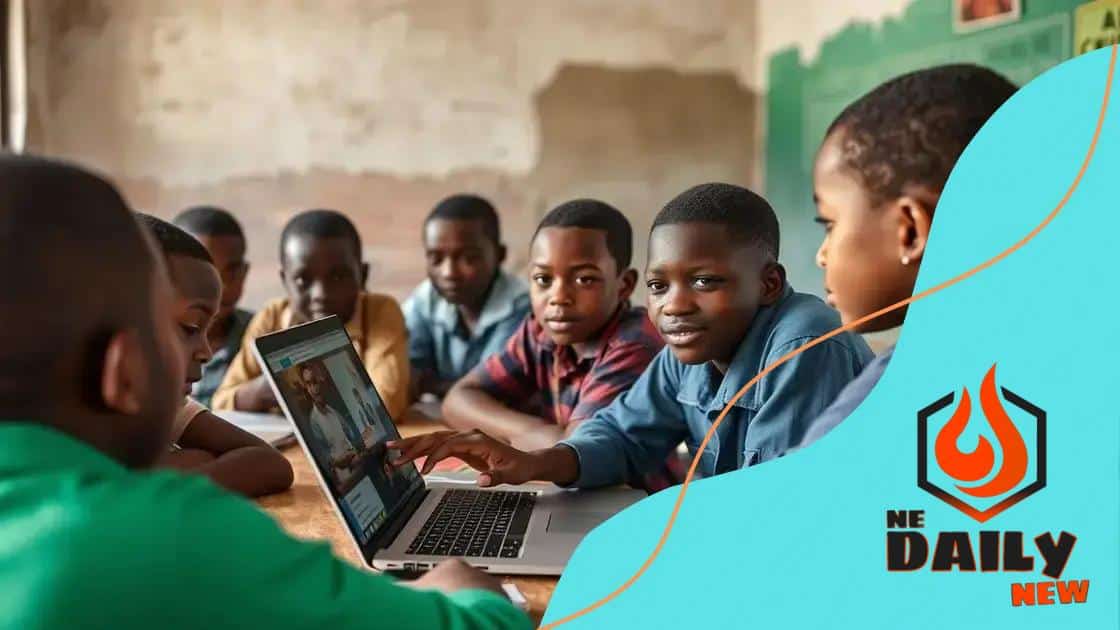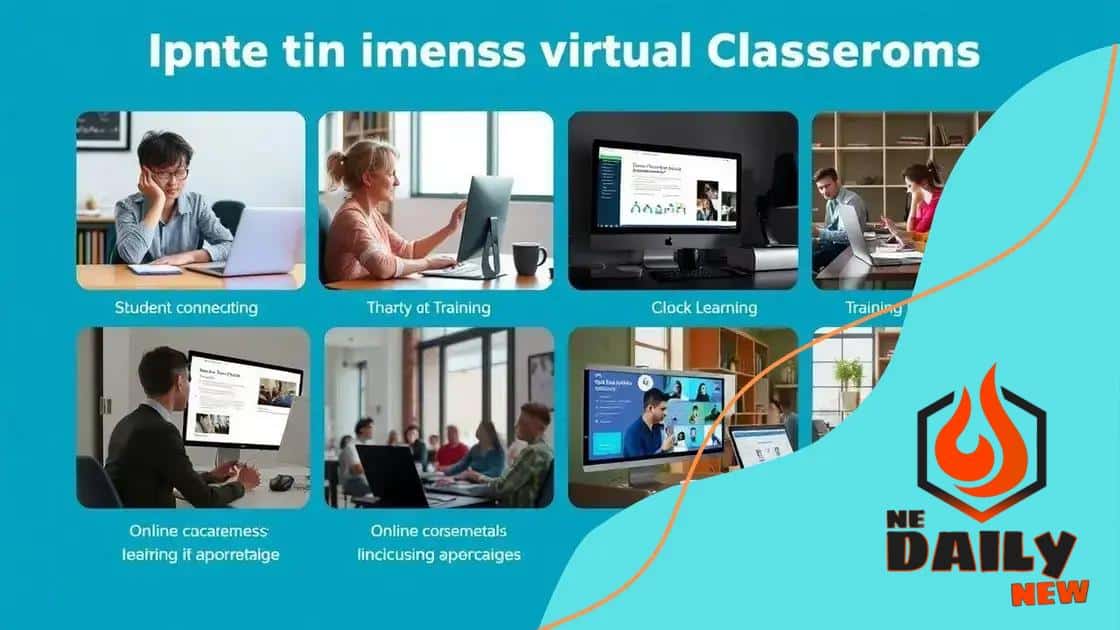Virtual classrooms in developing countries: Challenges and opportunities

Virtual classrooms in developing countries offer unique opportunities and challenges, utilizing technology like AI and VR to enhance accessibility, interactivity, and skills development while addressing barriers such as internet access and technological literacy.
Virtual classrooms in developing countries present a landscape filled with potential and hurdles. As education evolves, these platforms aim to bridge gaps, but what does that mean for everyone involved? Let’s dive in.
Understanding virtual classrooms in developing countries
Understanding virtual classrooms in developing countries is vital as education transitions into the digital era. These platforms provide unique opportunities for learners who may be geographically or economically disadvantaged.
Many regions face challenges like limited internet access and lack of technological resources. However, the benefits of virtual classrooms can be transformative.
Key Advantages
Among the numerous advantages, we can highlight:
- Increased accessibility: Students from remote areas can access quality education.
- Flexible learning: Learners can study at their own pace, fitting education into their busy lives.
- Diverse resources: Virtual classrooms often provide access to a wider range of materials and experts.
Despite these positive aspects, challenges remain. Teachers and institutions must be prepared to address issues such as inadequate training and technological limitations. Equipping educators with the necessary tools and skills is essential.
Addressing the Challenges
To optimize virtual classroom experiences, it’s important to undertake specific measures. Here are some strategies:
- Invest in infrastructure: Improving internet connectivity can help bridge the gap.
- Provide training: Ensuring teachers are trained in digital tools is crucial.
- Engage with communities: Building trust and outlining the benefits of online education can encourage participation.
By understanding virtual classrooms in developing countries, we pave the way for educational advancement. Embracing these changes can ultimately lead to better learning outcomes for many students.
Benefits of virtual learning environments
The benefits of virtual learning environments are significant and can greatly enhance educational experiences. With the rise of technology, these platforms are redefining how students learn and teachers instruct.
One major advantage is accessibility. Students from various backgrounds can join classes from their homes, making high-quality education available to more individuals than ever before.
Flexibility and Convenience
Another compelling benefit is the flexibility offered by virtual learning. Students can access materials anytime, allowing them to learn at their own pace. This adaptability is crucial for those balancing other responsibilities.
- Personalized learning: Students can tailor their educational journey to fit their needs.
- Diverse learning resources: Virtual platforms provide access to videos, articles, and interactive content.
- Time management: Learners can set their schedules, promoting better study habits.
Furthermore, virtual learning environments encourage collaboration. Students can work together on projects using online tools, promoting teamwork and communication. This setup prepares them well for future workplace environments, where remote communication is often key.
Cost-Effectiveness
Lastly, these environments can be cost-effective. Eliminating the need for physical space reduces operational costs for schools and students. Families save on transportation and other related expenses.
In summary, the benefits of virtual learning environments extend far beyond convenience. They promote inclusivity, flexibility, collaboration, and cost savings, making them an essential part of modern education.
Key challenges in implementing virtual classrooms

Implementing virtual classrooms comes with distinct challenges that can hinder the learning experience. Understanding these obstacles is crucial for educators and institutions aiming for success.
One major challenge is the lack of reliable internet access in many developing areas. Without sufficient bandwidth, students may struggle to connect, leading to missed lessons and frustration.
Technological Limitations
In addition to internet issues, many families may not own computers or tablets, which limits participation in virtual classrooms. Schools need to find ways to provide necessary devices or enhance local access.
- Insufficient training: Teachers often have little training in using digital tools effectively.
- Resource constraints: Many schools lack the budget for essential technology upgrades.
- Student engagement: Keeping students motivated in a virtual environment can be challenging.
Moreover, technological literacy is another barrier. Students and teachers may not be familiar with using online platforms, making it vital to include training resources as part of the implementation process.
Socioeconomic Factors
Beyond technology, socioeconomic factors also play a significant role. Many students may face distractions at home or have responsibilities that compete with their education. This situation can affect their ability to participate in classes fully.
It’s important to recognize that cultural perceptions of education can also influence how virtual classrooms are implemented. Some communities may prefer traditional methods and resist adopting new technologies.
Addressing these challenges requires collaboration among educators, parents, and local governments. By working together, they can create solutions that enhance the effectiveness of virtual classrooms and ensure broader access.
Technological requirements for effective virtual education
For effective virtual education, certain technological requirements must be met. Access to reliable technology is vital for both students and teachers to facilitate a seamless learning experience.
First and foremost, a strong internet connection is essential. Without it, students cannot reliably connect to virtual classrooms, participate in discussions, or access educational resources.
Essential Devices
Next, having access to the right devices greatly impacts learning outcomes. This includes:
- Laptops or tablets: These are crucial for accessing online courses and resources.
- Headphones: These help minimize distractions and improve concentration during virtual classes.
- Webcams: Important for engaging in face-to-face virtual interactions.
An effective virtual education system also needs a variety of software tools. Platforms for video conferencing, learning management systems (LMS), and collaboration tools enrich the learning experience.
Learning Management Systems
A learning management system is central to organizing courses and tracking student progress. It streamlines communication and provides a space for educators to share resources, assignments, and feedback.
In addition to these systems, educational platforms should be user-friendly. This is vital to ensure that students can navigate the learning tools with ease. Regular training for students and teachers on these tools fosters confidence and capability.
Lastly, technical support plays an important role. Access to help when issues arise keeps the learning process uninterrupted and maintains student engagement.
Future trends in virtual classrooms
The future of virtual classrooms is bright and filled with potential. As technology continues to advance, we can expect significant changes in how education is delivered. The adoption of innovative strategies will enhance the learning experience.
One notable trend is the integration of artificial intelligence in education. AI-driven tools can personalize learning by adapting to students’ individual needs and learning styles. This personalization enhances engagement and improves academic performance.
Greater Interactivity
Another exciting development is the push for greater interactivity in virtual classrooms. Educators will use advanced tools, such as virtual and augmented reality, to create immersive environments. These technologies allow students to participate in hands-on experiences without leaving their homes.
- Collaborative tools: More platforms will facilitate real-time collaboration among students.
- Gamification: Introducing game elements will make learning fun and engaging.
- Increased accessibility: Enhancements in technology will make education more accessible for everyone, regardless of location or socioeconomic status.
In addition, we may see an increase in hybrid models of education that combine online and in-person learning. This flexibility allows students to benefit from both environments, promoting a more comprehensive understanding of subjects.
Focus on Skills Development
The future will also emphasize preparing students for the workforce. Virtual classrooms will incorporate skills training, ensuring students develop relevant skills that align with market demands.
The emergence of new job markets necessitates that education evolves as well. Programs that teach skills such as coding, digital marketing, and data analysis will become increasingly popular.
Overall, the trends in virtual classrooms promise to transform how education is received and delivered. By embracing advancements, stakeholders in education can enhance the learning experience for future generations.
FAQ – Questions about Virtual Classrooms and Future Trends
What is the role of artificial intelligence in virtual classrooms?
AI personalizes learning experiences for students by adapting to their individual needs and improving engagement.
How will interactive tools change the learning environment?
Interactive tools like VR and gamification will make learning more engaging, allowing for hands-on experiences from home.
What are hybrid learning models?
Hybrid models combine online education and in-person classes, offering flexibility and a more comprehensive learning experience.
How will skills training be integrated into virtual classrooms?
Virtual classrooms will focus on teaching relevant skills for future careers, such as coding and digital marketing, to prepare students for the job market.





